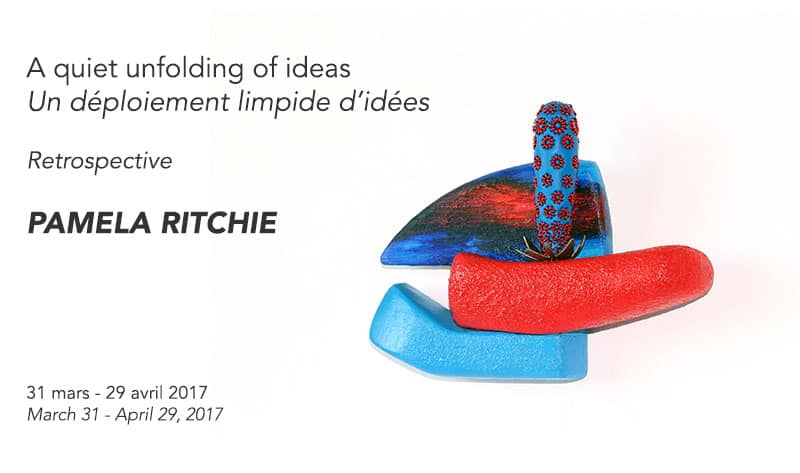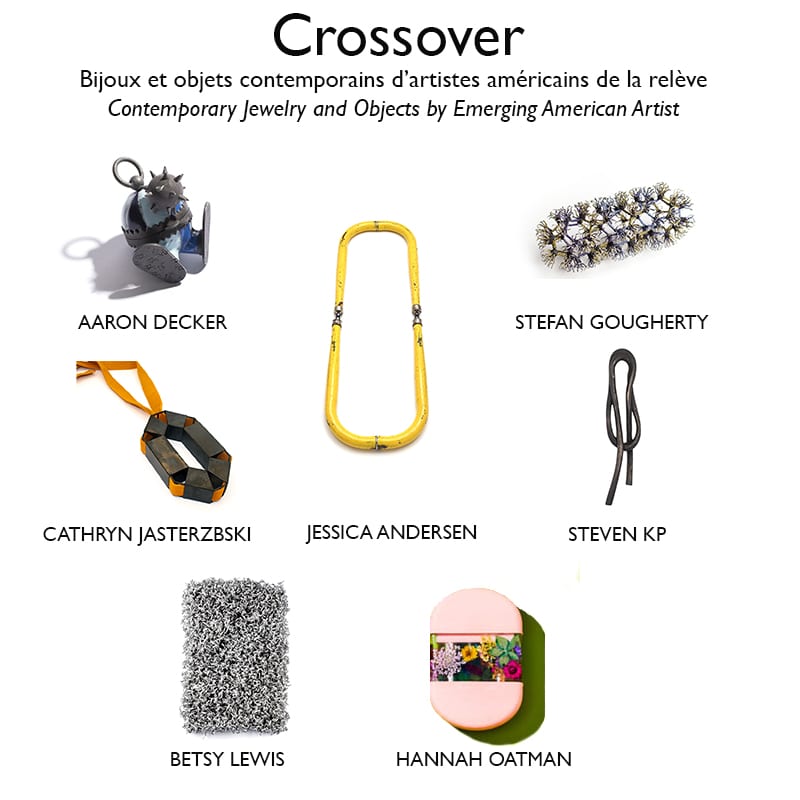
A QUIET UNFOLDING OF IDEAS : PAMELA RITCHIE
2017 Saidye Bronfman Award Laureate
It is with great excitement that Galerie Noel Guyomarc’h will be presenting « A quiet unfolding of ideas : Pamela Ritchie», from April 1 to April 29, 2017. This new exhibition aims at being both a retrospective and a tribute to a more than 35 years career artist, Pamela Ritchie, who is attending the gallery’s cases for the second time. The gallery represents the artist since 2005. She is the recipient of the prestigious Saidye Bronfman Award 2017, the foremost distinction in excellence in Canadian contemporary craft, one of the Governor General’s Awards.
A jewellery design teacher at Nova Scotia College of Art and Design, Halifax, Pamela Ritchie participated in more than a hundred solo and collectives exhibitions in Canada, the United States, Australia, Japon, Korea and Europe. She is regularly invited for lectures in Canada and abroad, and enjoys a well deserved international recognition of her work.
Her first exhibition at the gallery dates back to 2010 and consisted in a display of her series of that time, « With:In ». The new presentation, « A quiet unfolding of ideas », will on the contrary display works from all her major series and provide a broad understanding of Ritchie’s creative path and research.
Born in Nova Scotia, Pamela Ritchie studied fine arts at the Nova Scotia College of Art and Design, Halifax, where she now teaches. Attracted first by the theater world, she soon moved on to focus on jewellery, a field that allowed her to express her creativity while experimenting with a large panel of concepts and ideas. More than pure aesthetics, Pamela Ritchie’s work stands indeed on thorough thinking and deep reflexion.
Cancelled Icons, a series she started working on in 1982, was born from her questioning of what brings value to a jewel. Using postal stamps for and in place of gems, she points out the inner paradox of such a replacement. A stamp is nothing more than a worthless piece of paper, but at the same time it is essential to our daily life and to the delivery of letters, and becomes in her jewels the alter egos of what is traditionally precious.
With Wall-Flowers, in 1983, Pamela Ritchie took up the issue of a jewel’s wearability and of its official place. While on the phone with an officer from the Canada Council Art Bank, she asked if a jewellery exhibition could be considered. « Yes », was the answer, « as long as the pieces could be hung on a wall ». That answer gave her pause for thought, since jewellery’s place is not, she felt strongly, on a wall. She therefore conceived a series in which the pieces are indeed displayed on a wall, but hidden and made to disappear on their display background.
Concatenation, a series she worked on from 1987 to 1996, was inspired to her by the Chernobyl disaster. Traveling in the Netherlands, she found herself under a very heavy rain one night and got completely soaked. She learned a few days later that it has been the Chernobyl rains and witnessed a work colleague of hers run to his kitchen garden to destroy all fruits and vegetables. With Concatenation, Ritchie drew from organic shapes – beans, fishes, potatoes, sea cucumbers – but added undulating lines conjuring the idea of radiation. The pieces evoke how what is considered a source of life can suddenly turned to mean death and danger. Such duality is fascinating to Ritchie, and her entire body of work often bears marks of dual concepts.
With the Imaginary Landscapes and Kruser series, both started in 1996, her work became strongly linked with her study of a filigree technique from Norway, called « Bunadsylv ». Dating back to 3 000 B.C, this extremely time-consuming technique was the subject of her one-year study in Oslo and Telemark. Ritchie began using its very typical coiled shaped wires and included them in her pieces, even experimenting with 3D printing to recreate the shape. The idea of travel is very important in her work, as shown by her use of Bunadsylv and its influence in her creations.
Travel can also be found in her « geographic » titles – Imaginary Places, Alien Landscapes – in the use of the Norwegian word Kruser, or even more obvious in her use of stamps for Cancelled Icons, stamps being proper icons for travel and generally endowed with significant traveling imagery.
All Ritchie’s following series, Weddings in 2006, With:In in 2008 and Affinities in 2012, continue Ritchie’s exploration of shape and forms, influenced by aesthetic considerations of surface, color, texture and contrast, modernity and tradition. With With:In and Affinities, she supported her research on both mythological and philosophical considerations of how the universe was created and the scientific search for the origin of matter.
Materials, finally, play a major role in Ritchie’s creations. Her newest series, Alien Landscapes, combines wood and polymer plastic, the former a traditional craft material, the latter born from technical advances and never used in « traditional » jewellery. This balance between modern manufacturing methods and traditional approaches pervades all Ritchie’s work. To pick non-traditional materials is however not enough, as she insists on going further, exploring the whole range of possibilities and limits of a material to make it the perfect reflection of an idea, a concept or an emotion. Exploring shapes and color, she ended up producing that new series in which vibrant colors of blue and red and bold surface treatment with acrylic paint evoke some Alien Landscapes, as if from a distant planet.
By highlighting some major steps in Ritchie’s work and displaying pieces from all her different series, the retrospective exhibition « Pamela Ritchie: a quiet unfolding of ideas » will allow the audience to witness how the artist’s constant themes and ideas pervade her work and keep growing and maturing throughout her exploration process. For instance, some of the stamps jewels of « Cancelled Icons » bear the radiation marks of « Concatenation », and the Bunadsylv patterns are repeated until the newest pieces of « Alien Landscapes ». To Noel Guyomarc’h, the exhibition is also meant to highlight Ritchie’s refine technical perfectionism while insisting on the intense reflexive, cultural and even historical dimension of her work.
For Pamela Ritchie, making art is a fascinating process as it allows her to « create meaning ». She sees jewellery making as « a process of searching for meaning and a way of expressing what I find », « a search for some understanding of the complexity of existence, a complexity which is both fascinating and painful ». It is fascinating to her that such a small and « insignificant » object as a jewel could bear so many possible meanings, and on the other hand how it could produce such a burst of possibilities and questioning.
The Canadian Museum of History has acquired 15 pieces by the artist during this exhibition. To see the collection : Pamela Ritchie




